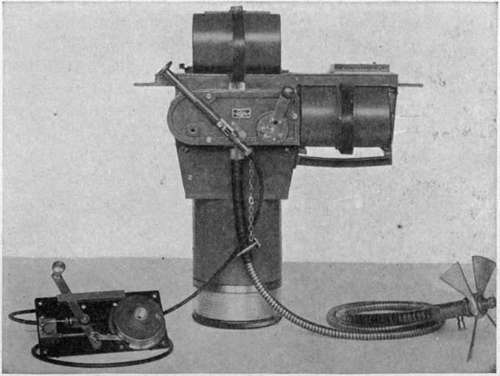Chief Differences Between Ground And Air Cameras
Description
This section is from the book "Airplane Photography", by Herbert E. Ives. Also available from Amazon: Airplane photography.
Chief Differences Between Ground And Air Cameras
Certain definite differences are thus seen to stand out between airplane cameras and the ordinary kind. It is essential that the apparatus for use in the air shall have high lens and shutter speed, means for rapid changing of plates, and anti-vibration suspension. Without these features a camera is of little use for aerial work. These requirements lead inevitably to greater complexity of design, One simplification over ground cameras, however, is brought about by the fact that all exposures are made on objects beyond the practical infinity point of the lens; consequently, all cameras are fixed focus. This fixed focus feature is a positive advantage in construction, since it permits of the simple rigid box form, desirable and necessary to withstand the strains due to the weight of the lens and the stresses from the plane. But with the abandonment of all provision for focussing in the air must go special care that the material used in constructing the camera body is as little subject as possible to expansion and contraction with temperature, since there is often a drop of 30 to 40 degrees Centigrade from ground to upper air. The effect of change of temperature on focus will be treated in the discussion of lenses.
In addition to these differences, we must keep in mind certain requirements which are conditioned by the nature and place of aerial navigation. Thus all mechanical devices which will fail to function at the low temperatures and pressures met at high altitudes are entirely unsuitable. Experience has shown, too, that we must avoid all mechanism depending primarily on springs and on the action of gravity. Vibration, and the motion of the plane in all three dimensions, conspire to render mechanical motions unreliable when actuated by these agencies. All plate changing, shutter setting, and exposing operations should be as nearly as possible positively controlled motions. Because of the cold of the upper air all knobs, levers and catches must be made extra large and easy to handle with heavy gloves. Circular knurled heads to such parts as shutter setting movements are to be avoided in favor of bat-wing keys or levers. Grooves for the reception of magazines must be as large and smooth as possible, and guides to facilitate the magazines' introduction should be provided (Fig. 50). No releases or adjustments which depend upon hearing or upon a delicate sense of touch are feasible in airplane apparatus. Wherever possible, large visible indicators of the stage of the cycle of operations should be provided. Loose parts are to be shunned, as they are invariably lost in service. Complete operating instructions should be placed on the apparatus wherever possible, to minimize the confusion due to changing and uninstructed personnel.

Fig. 50. - American model, English "L" type semi-automatic camera.
Continue to:
- prev: II. The Airplane Camera. Chapter III. The Camera - General Considerations. Chief Uses Of An Airplane Camera
- Table of Contents
- next: The Elements Of The Airplane Camera
Tags
camera, lens, airplane, aerial, film, exposure, photography, maps, birdseye
